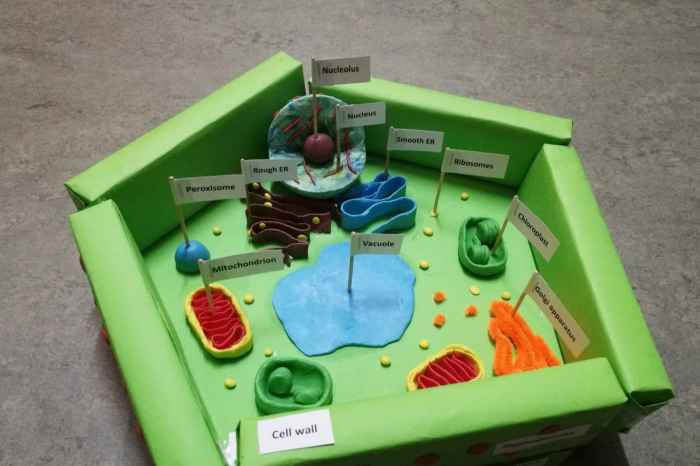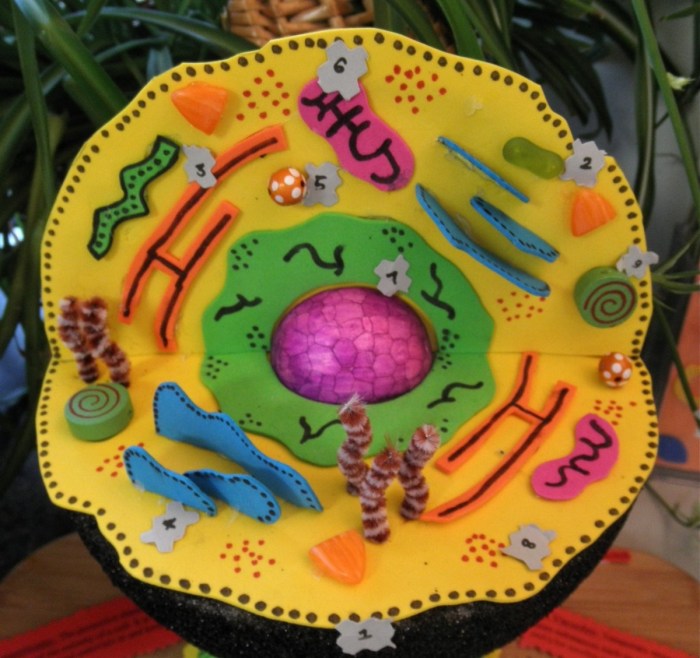Ever wondered what the tiny building blocks of life look like? How to Make a Cell Model 3D: A Step-by-Step Guide will take you on a journey into the fascinating world of cells. From the intricate structure of the nucleus to the bustling activity of the mitochondria, this guide will equip you with the knowledge and skills to create a 3D cell model that is both educational and visually stunning.
This project is perfect for anyone who wants to explore the intricacies of biology in a hands-on way. Whether you’re a student, teacher, or simply someone curious about the wonders of the microscopic world, this guide will provide you with all the information you need to build your own cell model.
Get ready to dive into the world of cells and unleash your creativity!
Creating a 3D Cell Model: A Guide to Building Your Own Microcosm
Delving into the fascinating world of cells can be a captivating experience, and what better way to understand their intricate structure and function than by building a 3D model? This hands-on project not only brings the microscopic world to life but also enhances your understanding of cellular processes and the vital roles these tiny building blocks play in all living organisms.
Creating a 3D cell model is a fantastic way to visualize the complexity of life at the cellular level. It allows you to see the relationships between different organelles and understand how they work together to maintain the cell’s life-sustaining functions.
You can even use your model to explore the differences between various types of cells, like the muscle cells that power our movement or the nerve cells that transmit information throughout our bodies.
Materials and Tools
Before you embark on your cell model construction journey, you’ll need to gather the necessary materials and tools. Here’s a list of what you’ll need, categorized for your convenience:
- Structural Materials
- Cardboard: A sturdy and readily available material for creating the cell’s basic shape and its larger organelles.
- Foam board: Ideal for adding intricate details and creating more complex structures.
- Clay or modeling dough: Flexible and versatile materials for shaping smaller organelles and adding texture.
- Decorative Materials
- Paint: Essential for bringing your cell model to life with vibrant colors, representing different cell components.
- Markers: Useful for adding labels, details, and fine lines.
- Glitter: A fun way to add sparkle and texture, especially for representing the rough endoplasmic reticulum.
- Fabric: Consider using fabric for representing the cell membrane or other delicate structures.
- Tools
- Scissors: For precise cutting of cardboard, foam board, and fabric.
- Glue: For securely attaching different parts of the model.
- Tape: For reinforcing connections and adding structural support.
- Toothpicks: For creating small structures, holding parts together, and labeling.
- Cell Membrane: Imagine this as the city’s outer wall, a selectively permeable barrier that controls what enters and exits the cell. It acts like a gatekeeper, allowing essential nutrients in while keeping harmful substances out. Think of it as a sophisticated security system that keeps the city safe and functional.
- Cytoplasm: This is the city’s bustling streets and public spaces, a gel-like substance that fills the cell. It’s where many cellular processes occur, including the transportation of materials and the production of energy. It’s the heart of the city, where everything happens.
- Nucleus: This is the city’s central command center, a spherical structure containing the cell’s genetic material (DNA). It’s like the city hall, where all the blueprints and instructions for the city’s development are stored and protected. It’s the brain of the cell, controlling all cellular activities.
- Organelles: These are the specialized buildings within the city, each performing a specific function. Here are some key organelles:
- Mitochondria: These are the city’s power plants, generating energy for the cell through cellular respiration. Think of them as the power stations that keep the lights on and the machines running.
- Ribosomes: These are the city’s factories, responsible for protein synthesis. They are like assembly lines, building the proteins needed for various cellular functions.
- Endoplasmic Reticulum (ER): This is the city’s transportation network, a network of interconnected membranes that helps transport materials throughout the cell. Think of it as a system of roads and highways, connecting different parts of the city.
- Golgi Apparatus: This is the city’s packaging and distribution center, modifying and sorting proteins before they are shipped to their destinations. Think of it as the post office, preparing and sending packages to different addresses.
- Lysosomes: These are the city’s recycling centers, breaking down waste products and worn-out organelles. They are like waste management facilities, keeping the city clean and efficient.
- Vacuoles: These are the city’s storage tanks, holding water, nutrients, and waste products. They are like reservoirs, providing a buffer for the city’s needs.
- Cardboard Construction: For the cell’s basic shape and larger organelles, cardboard is a reliable choice. You can use scissors to cut out shapes and glue them together to create the desired structures. This method is simple and cost-effective, allowing for quick assembly and experimentation.
- Foam Board Construction: For intricate details and more complex structures, foam board is a great option. Its smooth surface allows for precise cutting and shaping, and its lightweight nature makes it easy to work with. You can use a craft knife or a utility knife for precise cuts and create detailed structures like the Golgi apparatus or the endoplasmic reticulum.
- Clay or Modeling Dough Construction: For smaller organelles and adding texture, clay or modeling dough provides flexibility and versatility. You can shape them into various forms, representing the nucleus, mitochondria, or even ribosomes. Remember to let the clay dry completely before painting or attaching it to other parts of the model.
- Cutting and Shaping: Use sharp scissors or a craft knife for clean, precise cuts. For curved shapes, use a template or draw a guideline on the material before cutting.
- Assembly: Use glue or tape to securely attach different parts of the model. Consider using toothpicks to reinforce connections or create small structures. Make sure to allow sufficient drying time for the glue before moving on.
- Detailing: Once the basic structure is complete, you can add details to enhance the model’s realism. Use markers, paint, or glitter to represent different textures and features. You can even use fabric for the cell membrane or create a textured surface for the rough endoplasmic reticulum.
- Color Scheme: Choose colors that represent different cell components. For example, you could use green for the cytoplasm, blue for the nucleus, and red for mitochondria. Consider using contrasting colors to make each organelle stand out.
- Labeling: Create labels for each organelle using markers, paint, or small pieces of paper. You can use toothpicks to attach labels to the model or create a key with corresponding colors. Make sure the labels are clear and easy to read.
- Additional Features: To enhance the visual appeal, consider adding extra features. You can create a 3D representation of the cell membrane using fabric or translucent material. You can also use glitter to represent the rough endoplasmic reticulum or create a textured surface for the cytoplasm.
Be creative and experiment with different materials and techniques.
- Presentation Board: Create a presentation board with information about the cell. Include details about its structure, function, and the roles of different organelles. You can use pictures, diagrams, and short descriptions to make the board informative and engaging.
- Lighting: Proper lighting can enhance the visual impact of your model. Use a spotlight or a desk lamp to illuminate the model and highlight its details. Consider using different lighting angles to create interesting shadows and perspectives.
- Placement: Choose a suitable location for displaying your model. In a classroom setting, place it on a table or shelf where students can easily see it. For an exhibit, consider placing it in a well-lit area with a clear background.
Ensure the model is accessible and easy to view from different angles.
Cell Structure, How to make a cell model 3d

Before you start building, let’s dive into the basic structure of a typical eukaryotic cell. Think of it as a bustling city with specialized buildings (organelles) performing various tasks to keep the city (cell) running smoothly.
Construction Techniques

Now, let’s explore different methods for building your 3D cell model, each offering unique advantages:
Tips for Construction
Decoration and Labeling
Now comes the fun part: decorating and labeling your 3D cell model. Here’s a guide to make it visually appealing and informative:
Presentation and Display
With your 3D cell model complete, it’s time to showcase your creation. Here are some ideas for presenting and displaying it:
Ending Remarks

Building a 3D cell model is a rewarding experience that combines creativity with scientific knowledge. By carefully crafting each component and understanding the functions of different organelles, you gain a deeper appreciation for the complexity and beauty of life at its most fundamental level.
So, grab your materials, unleash your inner artist, and embark on this exciting journey into the microscopic world!
Essential Questionnaire: How To Make A Cell Model 3d
What are some alternative materials for building a cell model?
Besides cardboard, foam board, and clay, you can also use materials like balloons, yarn, beads, and even food items like candy and fruit to create different parts of the cell.
How do I ensure the accuracy of my cell model?
Refer to diagrams and images of real cells to ensure that your model accurately represents the relative sizes and positions of different organelles.
Can I use digital tools to create a 3D cell model?
Yes, there are several digital modeling software programs available that allow you to create 3D cell models virtually. This can be a great option for creating detailed and interactive models.
What are some ideas for displaying my finished cell model?
You can display your cell model on a presentation board, in a glass case, or even on a simple table. Consider adding a backdrop or lighting to enhance its visual appeal.